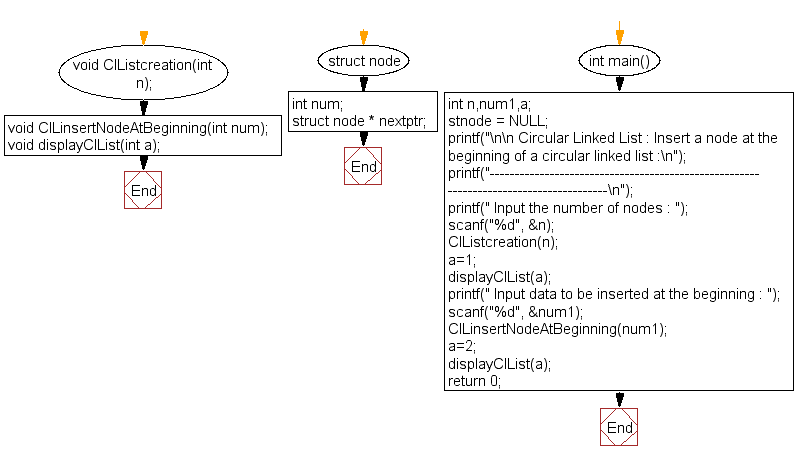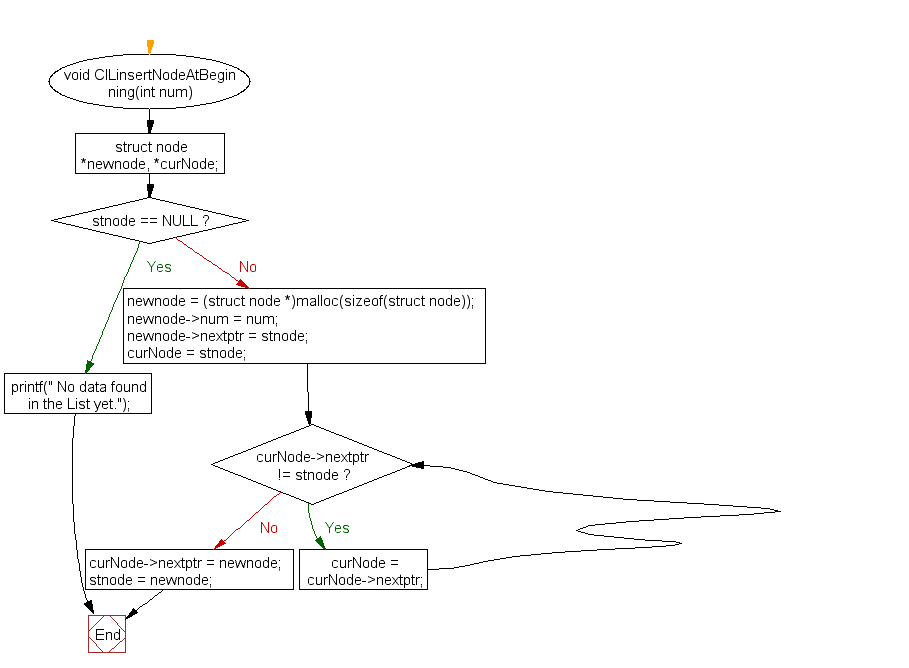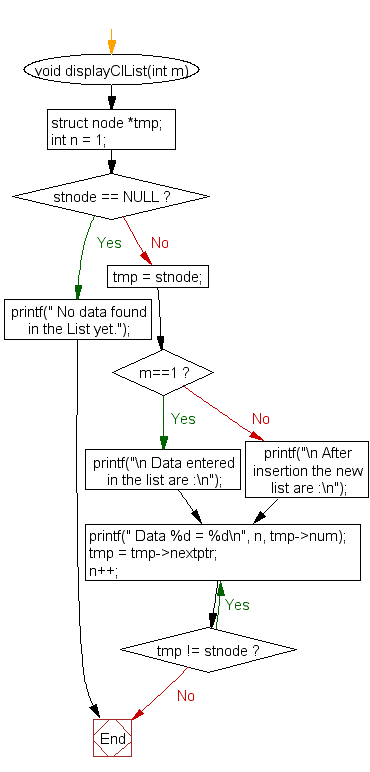C Exercises: Insert a node at the beginning of a circular linked list
13. Insert at Beginning of Circular Linked List
Write a program in C to insert a node at the beginning of a circular linked list.
Visual Presentation:

Sample Solution:
C Code:
#include <stdio.h>
#include <stdlib.h>
struct node {
int num;
struct node *nextptr;
}*stnode;
// Function prototypes
void ClListcreation(int n);
void ClLinsertNodeAtBeginning(int num);
void displayClList(int a);
int main() {
int n, num1, a;
stnode = NULL;
// User input for the number of nodes
printf("\n\n Circular Linked List : Insert a node at the beginning of a circular linked list :\n");
printf("--------------------------------------------------------------------------------------\n");
printf(" Input the number of nodes : ");
scanf("%d", &n);
// Creating a circular linked list
ClListcreation(n);
a = 1;
displayClList(a);
// Input data to be inserted at the beginning
printf(" Input data to be inserted at the beginning : ");
scanf("%d", &num1);
// Inserting a node at the beginning
ClLinsertNodeAtBeginning(num1);
a = 2;
displayClList(a);
return 0;
}
// Function to create a circular linked list
void ClListcreation(int n) {
int i, num;
struct node *preptr, *newnode;
if (n >= 1) {
stnode = (struct node *)malloc(sizeof(struct node));
printf(" Input data for node 1 : ");
scanf("%d", &num);
stnode->num = num;
stnode->nextptr = NULL;
preptr = stnode;
// Loop to create subsequent nodes and link them to form a circular list
for (i = 2; i <= n; i++) {
newnode = (struct node *)malloc(sizeof(struct node));
printf(" Input data for node %d : ", i);
scanf("%d", &num);
newnode->num = num;
newnode->nextptr = NULL; // Setting the next address of the new node as NULL
preptr->nextptr = newnode; // Linking the previous node with the new node
preptr = newnode; // Advancing the previous node to the new node
}
preptr->nextptr = stnode; // Linking the last node with the first node to form a circular list
}
}
// Function to insert a node at the beginning of the circular linked list
void ClLinsertNodeAtBeginning(int num) {
struct node *newnode, *curNode;
if (stnode == NULL) {
printf(" No data found in the List yet.");
} else {
newnode = (struct node *)malloc(sizeof(struct node));
newnode->num = num;
newnode->nextptr = stnode;
curNode = stnode;
// Finding the last node in the circular list
while (curNode->nextptr != stnode) {
curNode = curNode->nextptr;
}
// Linking the last node with the new node at the beginning
curNode->nextptr = newnode;
stnode = newnode;
}
}
// Function to display the circular linked list
void displayClList(int m) {
struct node *tmp;
int n = 1;
if (stnode == NULL) {
printf(" No data found in the List yet.");
} else {
tmp = stnode;
if (m == 1) {
printf("\n Data entered in the list are :\n");
} else {
printf("\n After insertion the new list are :\n");
}
// Loop to display nodes in the circular list
do {
printf(" Data %d = %d\n", n, tmp->num);
tmp = tmp->nextptr;
n++;
} while (tmp != stnode);
}
}
Sample Output:
Circular Linked List : Insert a node at the beginning of a circular linked list :
--------------------------------------------------------------------------------------
Input the number of nodes : 3
Input data for node 1 : 2
Input data for node 2 : 5
Input data for node 3 : 8
Data entered in the list are :
Data 1 = 2
Data 2 = 5
Data 3 = 8
Input data to be inserted at the beginning : 1
After insertion the new list are :
Data 1 = 1
Data 2 = 2
Data 3 = 5
Data 4 = 8
Flowchart:

ClListcreation() :

ClLinsertNodeAtBeginning() :

displayClList() :

For more Practice: Solve these Related Problems:
- Write a C program to insert a node at the beginning of a circular linked list and update the last node’s pointer correctly.
- Write a C program to insert a node at the beginning only if its value is lower than the current head’s value in a circular linked list.
- Write a C program to insert several nodes at the beginning of a circular linked list in succession and then display the list.
- Write a C program to insert a node at the beginning of a circular linked list and verify the circular structure by counting nodes.
Go to:
PREV : Circular Linked List Creation and Display.
NEXT : Insert at End of Circular Linked List.
C Programming Code Editor:
Have another way to solve this solution? Contribute your code (and comments) through Disqus.
What is the difficulty level of this exercise?
Test your Programming skills with w3resource's quiz.
